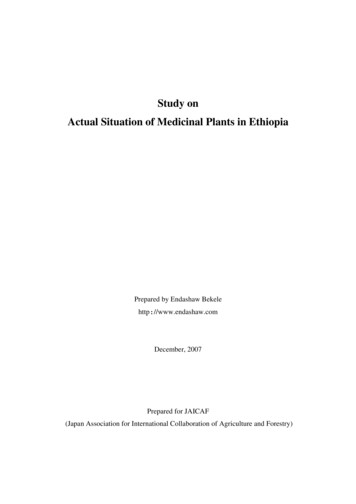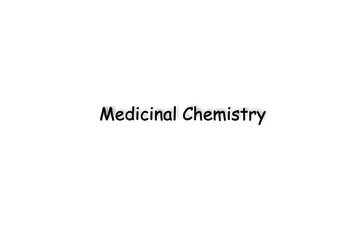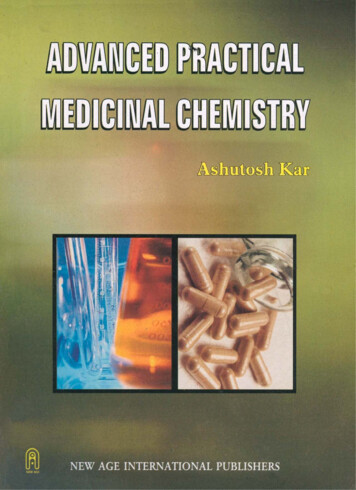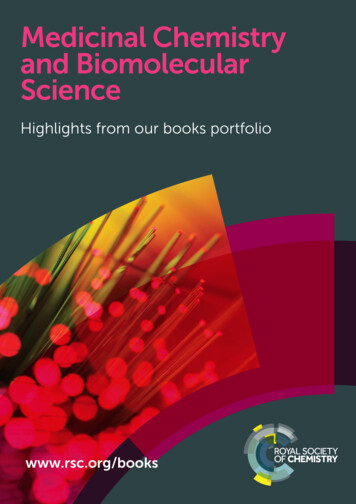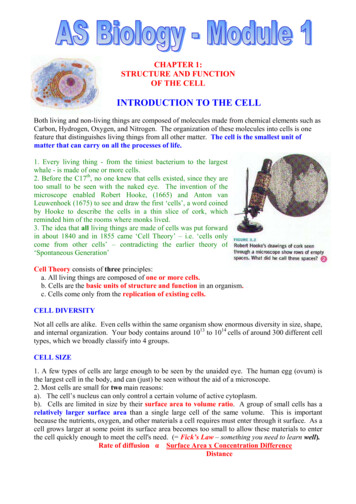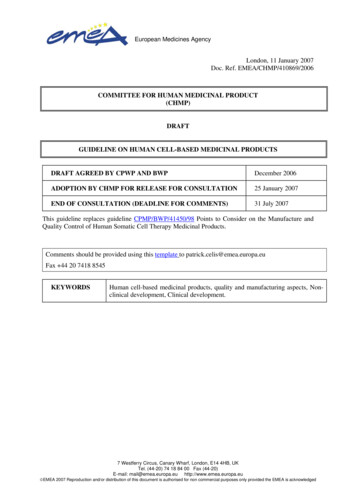
Transcription
European Medicines AgencyLondon, 11 January 2007Doc. Ref. EMEA/CHMP/410869/2006COMMITTEE FOR HUMAN MEDICINAL PRODUCT(CHMP)DRAFTGUIDELINE ON HUMAN CELL-BASED MEDICINAL PRODUCTSDRAFT AGREED BY CPWP AND BWPDecember 2006ADOPTION BY CHMP FOR RELEASE FOR CONSULTATION25 January 2007END OF CONSULTATION (DEADLINE FOR COMMENTS)31 July 2007This guideline replaces guideline CPMP/BWP/41450/98 Points to Consider on the Manufacture andQuality Control of Human Somatic Cell Therapy Medicinal Products.Comments should be provided using this template to patrick.celis@emea.europa.euFax 44 20 7418 8545KEYWORDSHuman cell-based medicinal products, quality and manufacturing aspects, Nonclinical development, Clinical development.7 Westferry Circus, Canary Wharf, London, E14 4HB, UKTel. (44-20) 74 18 84 00 Fax (44-20)E-mail: mail@emea.europa.eu http://www.emea.europa.eu EMEA 2007 Reproduction and/or distribution of this document is authorised for non commercial purposes only provided the EMEA is acknowledged
GUIDELINE ON HUMAN CELL-BASED MEDICINAL PRODUCTSTABLE OF CONTENTSEXECUTIVE SUMMARY. 31.INTRODUCTION (BACKGROUND) . 32.SCOPE. 33.LEGAL BASIS . 44.MAIN GUIDELINE TEXT . 44.1RISK ANALYSIS . 44.2QUALITY AND MANUFACTURING ASPECTS . 44.2.1Starting and raw materials. 54.2.2Manufacturing process. 74.2.3Characterisation. 94.2.4Quality control . 134.2.5Validation of the manufacturing process . 144.2.6Development Pharmaceutics . 154.2.7Traceability and biovigilance. 174.2.8Comparability. 174.3NON-CLINICAL DEVELOPMENT . 184.3.1.Pharmacology . 184.3.2.Toxicology . 194.4CLINICAL DEVELOPMENT . 214.4.1General aspects . 214.4.2Pharmacodynamics . 214.4.3Pharmacokinetics . 214.4.4Dose finding studies . 214.4.5Clinical Efficacy . 224.4.6Clinical Safety . 224.4.7Pharmacovigilance and Risk Management Plan. 22REFERENCES (SCIENTIFIC AND / OR LEGAL) . 23 EMEA 2007Page 2/24
EXECUTIVE SUMMARYThis guideline is replacing the existing CPMP Points to Consider on somatic cell therapy products. Ittakes into account the current legislation (including the Directive 2004/23/EC on Tissues and Cellsand the technical directives drawn from it) and the heterogeneity of human cell-based products,including combination products. A risk analysis approach can be used by the applicants to justify thedevelopment and evaluation plans and can be a basis for the preparation of a risk management plan.In the quality and manufacturing section, guidance is provided on the criteria and testing of all startingmaterials, on the design and validation of the manufacturing process, on characterisation of the humancell-based medicinal products, on quality control aspects, on the development programme, traceabilityand biovigilance and on comparability issues. Guidance specific to the matrix/device/scaffoldcomponent in combination products is provided.The guideline acknowledges that conventional non-clinical pharmacology and toxicology studies maynot be appropriate for cell-based medicinal products. Therefore the guideline addresses what nonclinical studies are relevant to demonstrate proof-of-principle, define the pharmacological andtoxicological effects predictive of the human response.The clinical development of human cell-based medicinal products might be associated with specialproblems. Guidance is therefore provided on the conduct of pharmacodyanamic/pharmacokineticstudies, dose finding and clinical efficacy and safety studies. Special consideration should be given topharmacovigilance aspects and the risk management plan for these products.1.INTRODUCTION (background)Rapid development in the fields of biology, biotechnology and medicine has led to development ofnew treatments and highly innovative medicinal products, including medicinal products containingviable cells. These new cell-based medicinal products have a high potential in the treatment of variousdiseases where there is a high unmet medical need.Human cell-based medicinal products are heterogeneous with regard to the origin and type of the cellsand to the complexity of the product. Cells may be self-renewing stem cells, more committedprogenitor cells or terminally differentiated cells exerting a specific defined physiological function.Cells may be of autologous or allogeneic origin. In addition, the cells may also be geneticallymodified. The cells may be used alone or associated with biomolecules, chemical substances andcombined with structural materials that alone might be classified as medical devices (combinationproducts).2.SCOPEThis multidisciplinary guideline will address development, manufacturing and quality control as wellas non-clinical and clinical development of cell-based medicinal products. This guideline is intendedfor products entering the MA procedure. However, the principles laid down in the guideline should betaken into consideration of applicants entering into the clinical trials.Cell-based medicinal products (CBMP) discussed in this document have the following characteristics:-They contain viable human cells1 of allogeneic or autologous origin undergoing a manufacturingprocess;They may be combined with non-cellular components;The cells might be genetically modified.Although this document does not cover non-viable cells and cellular fragments originating fromhuman cells, the underlying scientific principles may be applicable. This guideline does not cover cellbased medicinal product containing xenogeneic cells. EMEA 2007Page 3/24
3.LEGAL BASISThis guideline has to be read in conjunction with the introduction and general principles (4) and part 4of the Annex I to Directive 2001/832 as amended.Also, procurement and testing of cells from human origin must comply with overarching Directive2004/23/EC3 and technical directives drawn from it.4.MAIN GUIDELINE TEXT4.1Risk analysisThe risk posed by the administration of a cell-based medicinal product is highly dependent on theorigin of the cells, the manufacturing process, the non-cellular components and on the specifictherapeutic use. The variety of cell-based medicinal products can lead to very different levels of risksfor the patients, the medical personnel or the general population. This heterogeneity means that thedevelopment plans and evaluation requirements need to be adjusted according to a multifactorial riskanalysis.An initial risk analysis may be performed based on existing knowledge of the type of product and itsintended use. This should be updated by the applicant throughout the product life cycle as data arecollected to further characterise the risk. The risk analysis should be used to justify the productdevelopment and evaluation plans and as a basis for the preparation of a risk management plan inaccordance with the EMEA guideline on risk management systems for medicinal products for humanuse (EMEA/CHMP/96268/2005). In particular, the results of the risk analysis should be used: to identify risk factors associated with the quality and safety of the product to determine the extent and focus of the data required during non-clinical and clinicaldevelopment; to establish the need for risk minimisation activities, to determine the post market risk management activities to be specified in thepharmacovigilance plan.The following general risk criteria can be used in the estimation of the overall risk of the product:4.2 origin (autologous-allogeneic); ability to proliferate and differentiate; ability to initiate an immune response (as target or effector); level of cell manipulation (in vitro/ex vivo expansion/activation/genetic manipulation); mode of administration (ex vivo perfusion, local, systemic); duration of exposure (short to permanent); combination product (cells bioactive molecules or structural materials) availability of clinical data on or experience with similar products.Quality and manufacturing aspectsThis part of the guideline describes activities by manufacturers after receipt of cells from tissueestablishments.Cell-based medicinal products (CBMP) often involve cell samples of limited amount, mostly to beused in a patient-specific manner. This will raise specific issues pertaining to quality control testingdesigns for each product under examination. Since this document covers a large variety of CBMP, EMEA 2007Page 4/24
processes involved can vary from very simple to highly complex. Therefore, for certain cell-basedmedicinal products, the starting material, the active substance and the finished product can be closelyrelated or nearly identical. Consequently some requirements listed below could be inadequate for theproduct in question and in that case only relevant sections and items should be addressed.4.2.1Starting and raw materialsSince the manufacturing process of CBMP usually does not include terminal sterilisation, stringentpurification steps and viral removal or inactivation steps, acceptance criteria for all materials,especially those derived from human or animal origin, should be adequately defined according to theintended use.1. CellsThe active substance of a CBMP can be defined as viable cells after manipulation with or withoutother starting materials, i.e. the non-cellular components (e.g. matrix, device) and/or other materialsand reagents (e.g. growth factors, serum).Donated cellular material from single or pooled donors, once processed (see 4.2.2.1) may be: A single primary cell isolate used directly for cell-based product; Primary cells cultured for a few passages before being used for the CBMP; Cells based on a well-defined cell bank system consisting of a master cell bank and a workingcell bank.An adequately controlled cell storage system should be established to allow proper storage, retrievaland supply of cells without any alteration of their intended final characteristics. The cells should bestored under controlled and optimal conditions, to ensure cell viability, density, purity, sterility andfunction. Identity should be verified by relevant genotypic and phenotypic markers and the proportionof cells bearing these identity markers evaluated as an indicator of a homogeneous population.1.1 Cells from primary originThe quality criteria for the sourcing must meet the requirements of Directive 2006/17/EC4.Procedures and standards employed for the selection of appropriate donors and the exclusion of highrisk or otherwise unsuitable candidates should be clearly delineated and justified. If it is necessary topool cells from different donors, consideration should be given to the possibility that pooling ofallogeneic cell populations may increase the risk of undesired immunological responses in therecipient and compromise its therapeutic activity. In addition, pooling of cells from different donorsmay increase the risk of disease transmission. Depending on the nature of the source of the cells andtissues, other risk factors, e.g. previous radiation exposure, should be also considered and appropriatetesting should be performed.On receipt of the cells for use in a medicinal product, a specific virological screening programmeshould be in place, adapted to the type of cells, with validated assays capable of detecting humaninfectious agents with appropriate sensitivity. The starting materials should also be screened by directculture for bacteria, fungi and mycoplasma. When cells intentially originate from non-healthy tissues(e.g. tumour tissues) , the product specific acceptance criteria should be defined according to theintended use.Quality parameters aimed at the definition of acceptance criteria for a given organ or tissues should beset, taking into consideration shipment and storage conditions.In the case of autologous donation, the testing regimen of the starting material should be justifiedtaking into account the autologous use. EMEA 2007Page 5/24
1.2. Banking system for established cell linesWhere cell lines are used, a well characterised Master Cell Bank (MCB) and Working Cell Bank(WCB) should be established. Cell banking and characterisation and testing of the established cellbanks should comply with the ICH guideline Q5D5.2. Other materials and reagentsVarious materials are needed for collection, selection, culture or even genetic or phenotypicmodification of cells, such as other cells, enzymes, antibodies, cytokines, sera and antibiotics.Exposure to such materials can also compromise the quality, safety and efficacy of the final product.As a consequence, each substance used in the procedure should be clearly specified and evaluated asto its suitability for the intended use. The sterility, absence of contaminating agents and low endotoxinlevel of these products should be ensured. Materials, including cells that function as support forgrowth and adhesion in the form of a neo-organ or immuno-isolator should be evaluated and/orvalidated as to their suitability for the intended use.Quality of biologically active additives in culture media such as growth factors, cytokines andantibodies, should be documented with respect to identity, purity, sterility and biological activity andabsence of adventitious agents. It is recommended to avoid use of reagents with sensitisation potential.For viral safety aspects, information stated in Eudralex vol. 2B6, should be taken into consideration.The principles laid down in the general text of the European Pharmacopoeia on viral safety should befollowed for every substance of animal origin that participates in the production.Where appropriate, the Note for Guidance on the “Production and quality control of medicinalproducts derived by recombinant DNA technology”7 and the Note for Guidance on the “Productionand quality control of Monoclonal Antibodies”8 should be taken into account.When the products have a marketing authorisation, are CE marked or mentioned in a pharmacopoeia,appropriate references may be given.The following information must be added for materials of human or animal origin:2.1 Human derived materialsReagents of human origin (e.g. albumin, immunoglobulins) should be evaluated for their suitability ina manner identical to that employed for plasma-derived products as recommended in the CPMP Notefor guidance on plasma-derived medicinal products9. Measures should be taken to reduce the risk oftransmissible spongiform encephalophaties according to the relevant European legislation andguidelines. The use of synthetic media is recommended. If serum is required in the culture media, theuse of serum isolated from the same individual who donated the cells is preferred, where possible, toalternate allogeneic serum.2.2. Animal derived materialWhere cells or tissues of animal origin are used e.g. as supportive cells, the guidance given in “Pointsto consider on Xenogeneic Cell Therapy Medicinal Products”10 should be followed.Animal derived reagents may harbour infectious agents and may increase undesirable immunologicalresponses in the recipient. When applicable, the use of animal reagents should be avoided and replacedby non animal derived reagents of defined composition.The use of bovine, ovine or caprine derived agents should conform to the CPMP and CVMP Note forguidance on minimizing the risk of transmitting animal spongiform encephalopathy agents via humanand veterinary medicinal products11. EMEA 2007Page 6/24
When bovine serum is used, the recommendations of the Note for Guidance on the “Use of BovineSerum in the Manufacture of Human Biological Medicinal Product”12 should be followed. The use ofirradiated sera and/or alternative synthetic media is encouraged and should be considered.For viral safety testing of materials of other animal species, the table of extraneous agents to be testedfor in relation to the general and species-specific guidelines on production and control of mammalianveterinary vaccines13 and Note for Guidance on Production and Quality Control of AnimalImmunoglobulins and Immunesera for Human use14 should be consulted.3. Special considerations3.1. Special recommendations for the starting materials of combined Gene Therapy / Cell TherapyproductsWhen the cells in the active substance are genetically modified, the “Note for Guidance on the quality,preclinical and clinical aspects of gene transfer medicinal products”15 should be followed, which givesdetails on the quality control, characterisation and preclinical testing of gene transfer vectors. Cellpopulations which are transformed should be assayed for appropriate and reproducible expression ofthe newly acquired characteristics. Special attention should be paid on the level of expression andquality of the gene product(s) produced by the cells. As far as applicable and practicable, the newcharacteristics should be quantified and controlled.3.2. Special recommendations for matrix/device/scaffold components of combination productsCell-based medicinal products may incorporate structural components which are medical devices oractive implantable medical devices. Those devices should meet the essential requirements laid downin Directive 93/42/EEC16 concerning medical devices and Directive 90/385/EEC17 on theapproximation of the laws of the Member States relating to active implantable medical devices,respectively. Furthermore, if the device part has been evaluated by a Notified Body, the assessmentreport together with all relevant information of the device should be provided for evaluation. Cellbased medicinal products may also incorporate structural components which are not identical to, orused in the same way as in a medical device. All structural components should be fully characterisedand evaluated for their suitability for the intended use (See sections on Characterisation andDevelopment Pharmaceutics).Any matrices, fibres, beads, or other materials that are used in addition or combined to the cells shouldbe described and their function underpinned by means of chemical, biological, physical (e.g. structureand degradation) and mechanical properties. Inclusion of additional bioactive molecules should alsobe described and their impact should be evaluated.Additional product specific information of suitability of the matrix/device/scaffold of the cell-basedproduct for the intended use should be provided.4.2.2Manufacturing processThe manufacture of cell-based medicinal products should be carefully designed and validated toensure product consistency. The consistency specifications should be defined and justified.The manufacturing area should be physically separated from the area where biological fluids, tissuesor organs are collected/procured. If diverse tissues and cellular products are collected, processed andstored in the same manufacturing area there is an increased risk of cross contamination during eachstep of the procedure, e.g. via processing equipment or in storage containers such a liquid nitrogentanks, and therefore, adequate control measures to prevent cross-contamination should be put in place.Equipment and premises used for manufacturing of CBMP should be suitable and validated for asepticproduction. It is recommended that dedicated, product-specific or single-use equipment are used in the EMEA 2007Page 7/24
production, whenever possible. If the same equipment is used for production of e.g. multipleautologous products, sanitation and sterilisation procedures should be described and validated.A detailed description of the manufacture of the active substance and of the finished product should beprovided. The type of manipulation(s) required for cell processing and the physiological function ofthe cells shall be described. A flow diagram of the entire process starting from biologicalfluid/tissue/organ or from cell banks should be prepared indicating critical steps and intermediateproducts (e.g. intermediate cell batches), as well as operating parameters, in-process controls andacceptance criteria. Manufacture of combined medicinal products consisting of cells andmatrices/devices/scaffolds, require additional consideration regarding the cell-matrix/scaffoldinteractions and quality issues raised there from. Attention should be paid on biodegradable materialswhich may possess the potential for environmental changes (e.g. raising pH) for the cells during themanufacture or after administration.Information on procedures used to transport material during the manufacturing process of the product,including transportation and storage conditions and holding times, should be provided.1. Cell preparation proceduresAll cell preparation procedures should be justified in terms of their intended purpose.Inappropriate handling and improper processing of cells/tissues must be avoided as they can impair ordestroy the integrity and/or function of the cells and thus result in therapeutic failure. Microbiologicalcontrol is a pivotal aspect of process control and quality evaluation of all cell preparations. Monitoringof in vitro cell culturing should include tests for the absence of adventitious agents, at selected stagesof the production. The culture should be examined for any microbial contamination in accordance withthe culturing procedure and growth characteristics of the cells.After appropriate controls have been performed/implemented, the biological fluid/tissue /organ canundergo one or more of the following steps:1.1. Organ/tissue dissociationThe procedure to obtain the cells from the organ/tissue has to be described (type of enzyme, media,etc.) and validated. Consideration should be given to the degree of disruption applied to the tissue inorder to preserve functional integrity of the cellular preparation and minimize cell-derived impuritiesin the product (cell debris, cross contamination of other cell types). Special consideration should begiven to reagent-derived adventitious agents.1.2. Isolation of the cell population of interestAny procedure used to isolate and / or purify the cell population of interest should be described. Itseffectiveness should be addressed in relation to the intended use and the method(s) should bevalidated.1.3. Cell cultureDuring in vitro cell culture, consideration should be given to ensure optimal growth and manipulationof the isolated cells. The processing steps should be properly designed to preserve the integrity andcontrol the function of the cells. The procedures for any manipulation should be documented in detailand closely monitored according to specific process controls. Duration of cell culture and maximumnumber of cell passages should be clearly specified and/or validated. The relevant genotypic andphenotypic traits of the primary cell cultures, of the established cell lines and the derived cell clonesshould be defined and their stability with respect to culture longevity determined.Consistency/repeatability of the cell culture process should be demonstrated and the culture conditionsincluding the media and the duration should be optimised with respect to the intended clinical functionof the cells. EMEA 2007Page 8/24
Special consideration should be given to the growth potential of cells in response to growth factorssince cell subpopulations may gain a growth advantage under defined in vitro culturing conditions.1.4. Cell modificationVarious treatments (physical, chemical or genetic) can be applied to cells. The method used to modifythe cells should be fully described. In the case of genetic modification of cells, requirements set up inthe Note for guidance on Quality, preclinical and clinical aspects of gene transfer medicinal products15should be followed.1.5. Cells cultured in or on a matrix/device/scaffoldIf the cells are grown directly inside or on a matrix/device/scaffold, the quality of the combinedproduct relies predominantly on the properly controlled manufacturing process. For such products, thecell culture process has to be thoroughly validated and the effect of the device on the cell growth,function and integrity has to be taken into account.2. In-process controlsThe manufacturing process needs to be controlled by several in-process controls at the level of criticalsteps or intermediate products. Intermediate cell products are products that can be isolated during theprocess; specifications of these products should be established in order to assure the reproducibility ofthe process and the homogeneity of the final product. Tests and acceptance criteria should bedescribed. If storage occurs, it is necessary to validate storage conditions (e.g. time, temperature).3. Batch definitionThe purpose of the batch definition is to ensure consistency and traceability. A clear definition of aproduction batch from cell sourcing to labelling of final container should be provided (i.e. size,number of cell passages/cell duplications, pooling strategies, batch numbering system). In theautologous setting, the manufactured product should be viewed as a batch.4. Container and closure systemA description of the container closure system should be provided. Compatibility with the productshould be demonstrated. It should be indicated if the container closure has a CE marking under theMedicinal Devices Directive 93/42/CEE16. Information on the sterilisation procedures of the containerand the closure should be provided.4.2.3CharacterisationThe characterisation of a CBMP should encompass all the components present in the finished product.Characterisation may prove particularly challenging for products containing cells together withmatrices, scaffolds and innovative devices. Characterisation data are likely to be necessary for singlecomponents as well as the combined final product. Characterisation data could encompass dataobtained throughout the development and/or manufacturing process. It should be noted that in acombined product the characteristics of both the cellular and the non-cellular components may bealtered by the process of integration.An extensive characterisation of the cellular component should be established in terms of identity,purity, potency and suitability for the intended use, unless justified.The expected biological function of a CBMP encompasses complex interactions that may range from abiochemical, metabolic or immunological action to the structural replacement of damaged tissue ororgan. Therefore, the requirements for a complete characterisation of the active substance in terms ofbiological function could be very taxing. Moreover the specific mechanism of action is often difficult EMEA 2007Page 9/24
to pinpoint to specific molecular entity but it is more dependent on the functionality of the cellularcomponents acting in a “tissue-like” fashion as a whole. Therefore, when considering the extent ofcharacterisation, the following issues should be taken into account: i) autologous cells vs. allogeneiccells, ii) extensively or minimally manipulated in vitro, iii) immunologically active or neutral, iv)proliferative capacity of the cells, v) cell-like or tissue-like organisation and dynamic interactionsamongst cells and with the structural component, vi) intended use.Non-cellular components should be characterised in the context of their required function in thefinished product. This includes structural components designed to support the cellular componentssuch as scaffolds or membranes which should be identified and characterised in chemical and physicalterms such as porosity, density, microscopic structure an
The risk analysis should be used to justify the product development and evaluation plans and as a basis for the preparation of a risk management plan in accordance with the EMEA guideline on risk management systems for medicinal products for human use (EMEA/CHMP/96268/2005). In particular, the results of the risk analysis should be used:


